When seeing the Grand Canyon for the first time one is at a loss for words or even unable to comprehend the unbelievable wonder of its creation. It is such a spectacular sight that no picture can possibly do it justice.
Few people have not seen pictures of the Grand Canyon and still when we first see it, we cannot be anything else but impressed and in awe of this majestic sight. What then must it have been like for the first people who happened on this unbelievable vision of nature at its best?
The oldest human artifacts discovered date to the Paleo-Indian period nearly 12,000 years ago. For thousands of years the Puebloans, Cohoninas, the Paiutes, Cerbats and the Navajoes lived as semi-nomadic hunter-gatherers and canyon dwellers in the area of the canyon.
There are approximately 2,000 known archaeological sites within the park boundaries giving evidence of their existence and their way of life. The most accessible site is Tusayan Pueblo believed to be constructed sometime around 1185 and possibly housing about thirty people. There is further evidence that in the late 1200's these nomadic people seemed to have left the area of the canyon. It is thought that the mass exodus may have been due to a climate change since a lot of their existence depended upon agriculture.
Following this for a period of about one hundred years the canyon remained deserted by humans until the Paiutes, Cerbats and later the Navajoes returned to reestablish their settlements. The Dines, relatives of the Apache, later became inhabitants of the canyon as well until in 1882 when all Native Americans were forced onto reservations.
In 1540, Captain Garcia Lopez de Cardenas lead a party of Spanish soldiers into the Grand Canyon on an expedition but left believing that it was impossible to get through many of the areas within the canyon. It was another two hundred years before a second expedition arrived in the form of two Spanish priests. They were searching for a route from Santa Fe, New Mexico to Monterey, California. In 1826, James Ohio Pattie and a group of trappers reached the canyon but little is known about them. And in the mid 1800's Lieutenant Joseph Ines attempted to explore the area as well but eventually gave up his quest.
John Wesley Powell (1834 – 1902) was the first geologist to navigate the often treacherous Colorado River through the Grand Canyon studying the geology of the canyon. He later founded the U.S. Geological Society and wrote several books on the subject. His first trip was in 1869 and his second, more successful trip, was between 1871 and 1872. Others later followed him discovering and recording additional information about this fabulous creation as they went.
In 1901, the Grand Canyon Railway was established and ran between Arizona and the South Rim opening the canyon up to tourists who had previously only been able to visit by stagecoach. In 1905 a luxury hotel, the El Tovar, was opened on the South Rim and the Phantom Ranch in the Inner Gorge opened in 1922.
In May, 1933 the Watchtower at Desert View Point opened allowing visitors to see for over one hundred miles on a clear day and be able to watch the Colorado River as it winds through the canyon. The Watchtower was designed by Mary Elizabeth Colter using rock from the canyon. She insisted that the rock of the Tower blend into the rock of the canyon walls. Paintings and artwork decorate the inside walls. It is on the eastern end of the South Rim of the canyon. Standing seventy feet tall, it is thirty feet at its base. The Watchtower sits on a promontory over the canyon.
In the early 1900's, miners very quickly discovered that tourism was much more lucrative and easier than the often difficult and treacherous conditions of mining. Before long, and especially with the addition of the railroad, the Grand Canyon, with its awe inspiring views, became a popular attraction for tourists.
The Grand Canyon was given Federal protection as a Forest Reserve in 1893 and later became a National Monument. In 1919, it achieved National Park status receiving 44,173 visitors. It currently receives close to five million visitors each year.
Today the South Rim remains the most popular destination as the North Rim is more remote with fewer services. The newer addition of the Grand Canyon Skywalk, which is 4,000 feet above the Colorado River on the West Rim, has encouraged an influx of visitors to that area in recent years. It has a glass bottomed observation deck and reaches seventy feet over the canyon's rim. The West Rim is owned and operated by the Hualapai Indian Tribe.
On a recent visit to this marvel of nature, we took the shuttle from one view point to the next. Knowing a little bit about the history of one of the 7th Wonders of the World enhanced what we already considered an exciting visit from breath-stopping beauty alone. In some places the rock walls plunged to a depth of a mile below to the Colorado River. There were smiles on every face we passed as we followed paths and walked to view points. Happiness seemed to abound in this area of beauty.
When you look down into the canyon below and see the different layers of history that nature has preserved for us, it puts life into perspective. On a visit to many places you feel you're glad you came and you enjoyed what you saw but may not come back. But on a visit to the Grand Canyon, you will know you definitely want to return to view its beauty again.
Subscribe to:
Post Comments (Atom)










































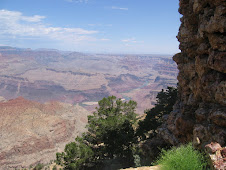
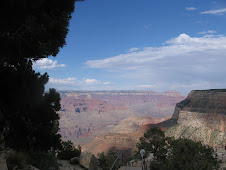
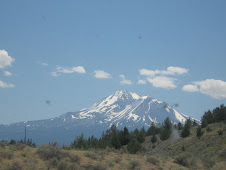



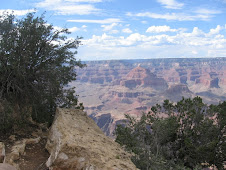
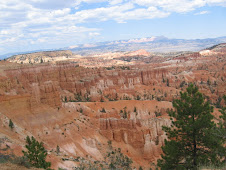
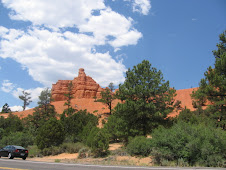


































No comments:
Post a Comment